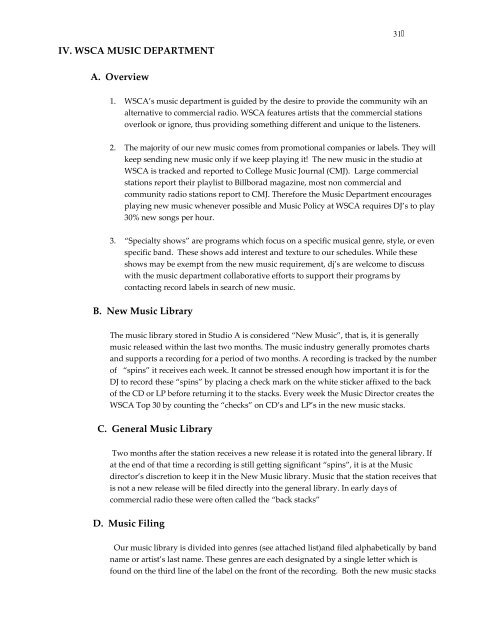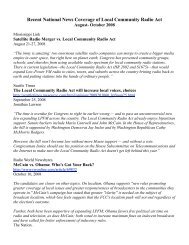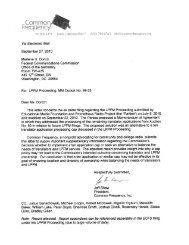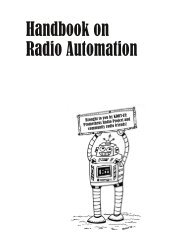WSCA Station Handbook and Training Manual - Prometheus Radio ...
WSCA Station Handbook and Training Manual - Prometheus Radio ...
WSCA Station Handbook and Training Manual - Prometheus Radio ...
Create successful ePaper yourself
Turn your PDF publications into a flip-book with our unique Google optimized e-Paper software.
31<br />
IV. <strong>WSCA</strong> MUSIC DEPARTMENT<br />
A. Overview<br />
1. <strong>WSCA</strong>’s music department is guided by the desire to provide the community wih an<br />
alternative to commercial radio. <strong>WSCA</strong> features artists that the commercial stations<br />
overlook or ignore, thus providing something different <strong>and</strong> unique to the listeners.<br />
2. The majority of our new music comes from promotional companies or labels. They will<br />
keep sending new music only if we keep playing it! The new music in the studio at<br />
<strong>WSCA</strong> is tracked <strong>and</strong> reported to College Music Journal (CMJ). Large commercial<br />
stations report their playlist to Billborad magazine, most non commercial <strong>and</strong><br />
community radio stations report to CMJ. Therefore the Music Department encourages<br />
playing new music whenever possible <strong>and</strong> Music Policy at <strong>WSCA</strong> requires DJ’s to play<br />
30% new songs per hour.<br />
3. “Specialty shows” are programs which focus on a specific musical genre, style, or even<br />
specific b<strong>and</strong>. These shows add interest <strong>and</strong> texture to our schedules. While these<br />
shows may be exempt from the new music requirement, dj’s are welcome to discuss<br />
with the music department collaborative efforts to support their programs by<br />
contacting record labels in search of new music.<br />
B. New Music Library<br />
The music library stored in Studio A is considered “New Music”, that is, it is generally<br />
music released within the last two months. The music industry generally promotes charts<br />
<strong>and</strong> supports a recording for a period of two months. A recording is tracked by the number<br />
of “spins” it receives each week. It cannot be stressed enough how important it is for the<br />
DJ to record these “spins” by placing a check mark on the white sticker affixed to the back<br />
of the CD or LP before returning it to the stacks. Every week the Music Director creates the<br />
<strong>WSCA</strong> Top 30 by counting the “checks” on CD’s <strong>and</strong> LP’s in the new music stacks.<br />
C. General Music Library<br />
Two months after the station receives a new release it is rotated into the general library. If<br />
at the end of that time a recording is still getting significant “spins”, it is at the Music<br />
director’s discretion to keep it in the New Music library. Music that the station receives that<br />
is not a new release will be filed directly into the general library. In early days of<br />
commercial radio these were often called the “back stacks”<br />
D. Music Filing<br />
Our music library is divided into genres (see attached list)<strong>and</strong> filed alphabetically by b<strong>and</strong><br />
name or artist’s last name. These genres are each designated by a single letter which is<br />
found on the third line of the label on the front of the recording. Both the new music stacks













